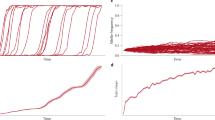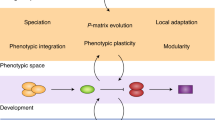Abstract
ONE of the greatest differences between genetics to-day and genetics of thirty years ago is to be found in the changed attitude of geneticists towards the relation of a gene to the character, or characters, which it affects. The early geneticists equated a given gene difference to the character difference from which its existence was inferred. The gene for tallness in peas gave tall peas and its allelomorph gave short peas. The significance of the fact that a tall pea, as Mendel himself observed, could be 6 ft. tall or 7 ft. tall or of intermediate height was overlooked ; the variation in height of tall peas was not discontinuous and so was not obviously attributable to a gene or genes detectable by the Mendelian technique. Such an attitude is very understandable because the success of Mendelian analysis lay in its concentration on simple character differences, in its exclusion of all extraneous variation from account. But this outlook carried with it disadvantages too, for concentration on discontinuous variation in experiment led easily to the assumption that the variation by which evolutionary changes were effected was just as sharply and obviously discontinuous. The outcome was the mutation theory of evolution on one hand and the presence and absence theory on the other.
This is a preview of subscription content, access via your institution
Access options
Subscribe to this journal
Receive 51 print issues and online access
$199.00 per year
only $3.90 per issue
Buy this article
- Purchase on Springer Link
- Instant access to full article PDF
Prices may be subject to local taxes which are calculated during checkout
Similar content being viewed by others
References
Bateson, W., "Mendel's Principles of Heredity", University Press, Cambridge (1909).
Bridges, C. B., Amer. Nat., 56, 51 (1922).
Fisher, R. A., Trans. Ent. Soc., 75, 269 (1927).
Muller, H. J., Proc. 6th Int. Congr. Genetics, 1, 213 (1932).
Timoféeff-Ressovsky, N. W., Nachr. Ges. Wiss. Göttingen (Biol.) (N.F.), 1, 53 (1934).
Ford, E. B., Biol. Rev., 12, 461 (1937).
Muller, H. J., "The New Systematics" (p. 185). Clarendon Press, Oxford (1940).
Huxley, J. S., "Evolution", Allen and Unwin, London (1942).
Waddington, C. H., NATURE, 150, 563 (1942).
Mather, K., Biol. Rev. (in the Press).
Haskell, G. M. L. (in preparation for publication).
Mather, K., J. Genet., 41, 159 (1941).
Mather, K., and de Winton, D., Ann. Bot. N.S., 5, 297 (1941).
Mather, K. (unpublished).
Brieger, F., "Selbststerilität und Kreuzungssterilität", Springer, Berlin (1930).
Author information
Authors and Affiliations
Rights and permissions
About this article
Cite this article
MATHER, K. POLYGENIC BALANCE IN THE CANALIZATION OF DEVELOPMENT. Nature 151, 68–71 (1943). https://doi.org/10.1038/151068a0
Issue Date:
DOI: https://doi.org/10.1038/151068a0
This article is cited by
-
SSR- and SNP-related QTL underlying linolenic acid and other fatty acid contents in soybean seeds across multiple environments
Molecular Breeding (2012)
-
Polygenic systems controlling the expression of major mutant genes which affect chaeta number in Drosophila melanogaster
Heredity (1954)
-
The evolution of heterochromatin in the genus tribolium (Tenebrionidae: Coleoptera)
Chromosoma (1950)
-
The heterochromatin problem in cytogenetics as related to other branches of investigation
The Botanical Review (1949)
-
The role of major genes in the evolution of economic characters
Journal of Genetics (1948)
Comments
By submitting a comment you agree to abide by our Terms and Community Guidelines. If you find something abusive or that does not comply with our terms or guidelines please flag it as inappropriate.



